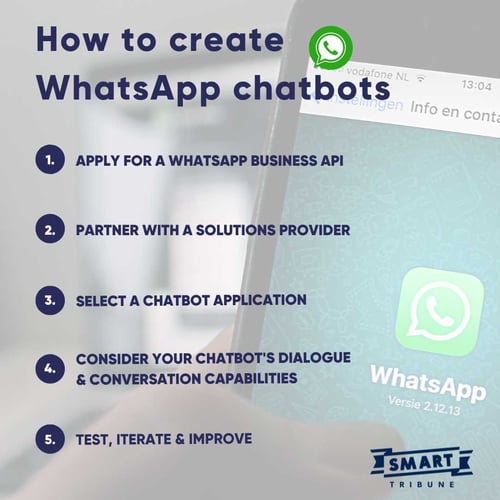
It’s no longer good enough for companies to be present on a few select customer communication channels. We live in an era of omnichannel, omnipresent communication. Today’s consumers expect to interact with brands on the channels of their choosing, whenever they please. What’s more, they expect near-instant responses to their queries.
Companies must step up or risk damaging customers’ experience and seeing them take their business elsewhere. So, how can companies meet consumers’ increasing expectations?
By implementing chatbots.
Read more: 5 Reasons Your Business Needs an Ecommerce Chatbot.
Chatbots—automated tools that engage customers in conversation—allow companies to answer customers’ queries while minimising the resources required to do so. For example, companies can use chatbots to help prospects navigate their website and make purchases. However, chatbots have a downside—they’re usually only available on companies’ websites. This is where WhatsApp chatbots come in.
This article delves into WhatsApp chatbots, exploring what they are, whether you should use one, how to create a WhatsApp chatbot, their benefits, and how they enhance customer service.
Table Of Contents
- What is a WhatsApp chatbot?
- Should you use WhatsApp chatbots?
- How to create WhatsApp chatbots?
- WhatsApp Business
- The benefits of WhatsApp chatbots
- Using WhatsApp chatbots to enhance customer service
- The future of chatbots
What is a WhatsApp chatbot?
WhatsApp chatbots are exactly as they sound: automated chatbots that run on the WhatsApp platform. They work just like other chatbots, sending customers messages, responding to their queries, and helping them navigate their buying journey.
Think of WhatsApp chatbots as the latest iteration of chatbot technology. Companies have long recognised how powerful chatbots can be, improving customers’ experience while minimising unnecessary customer service expenditure.
WhatsApp chatbots provide the same level of customer service and support as regular chatbots. But consumers don’t need to visit companies’ websites to gain answers to their questions from these bots—they can just ping them by sending a message through the world’s most popular messaging app.
Should you use WhatsApp chatbots?
Utilising WhatsApp chatbots offers the best of both worlds. Chatbots automatically provide around-the-clock service and instantly respond to customers’ queries. They allow companies to do more with less, increasing their customer service capabilities without having to scale their customer service team.
Meanwhile, WhatsApp boasts over 2 billion monthly active users, and its user base is increasing each year. It’s a channel consumers already know and love—which makes it ideal for customer service. Companies can meet consumers where they are, offering proactive assistance that’s more likely to boost engagement.
For example, rather than visiting your website and logging in to track an order status, customers can just ping off a quick WhatsApp message and receive a near-instant response.
Specific WhatsApp chatbot use cases
Okay, enough theory—let’s explore precisely how companies can use WhatsApp chatbots to boost their customer experience.
1. Generating sales: WhatsApp chatbots can attract sales via ads. For example, a company might run a series of social ads on Instagram and Facebook that contain a call-to-action (CTA), something simple and direct, like ‘Contact Us’. When customers click the CTA, they are redirected to the WhatsApp chatbot, which they can use to place orders.
2. Support throughout the sales funnel: Companies can engage WhatsApp chatbots throughout all stages of the sales funnel. For example, prospects can use WhatsApp chatbots to ask about an item’s price, the various sizing options that are available, when it’ll next be in stock, and its scheduled delivery date. Post-purchase, they can use the same WhatsApp chatbot to schedule returns, sort out refunds, or leave a review.3. To gather feedback: As things stand, 89% of companies compete primarily based on customer experience (CX). Having a fantastic CX is a huge competitive advantage—it sets you apart from other companies and boosts your brand’s wider reputation. Therefore, companies must regularly check in to understand what they’re doing well and where their CX is falling short. As management guru Peter Drucker once said, ‘What gets measured gets managed’.
Companies can use WhatsApp chatbots to gather product reviews, solicit feedback on the sales process; and help determine customer satisfaction (CSAT) scores. Best of all, these reviews are incredibly easy for customers to leave. They just have to open WhatsApp and ping off a quick message (or select a suitable emoji)—the process takes a matter of seconds.
4. Abandoned cart recovery: Unfortunately, 68.8% of all carts are abandoned during the sales process. Perhaps the customer was too busy to finalise the sale, wasn’t sure if they should go ahead with it, or needed to wait until payday to complete checkout.
But there’s good news—by sending a personalised message reminding customers that they have products waiting in their cart, companies can encourage prospects to re-engage with the buying process. One company even used WhatsApp reminders to recover a massive 70% of its abandoned carts.
However, remember a few clear rules. First, don’t be overly pushy. Gently remind customers that they’ve left some products in their cart—don’t demand that they check out. Second, remind them of any upcoming deadlines if relevant (e.g. 'Complete your purchase before the 20% sale ends this Friday'). Third, make it as easy as possible for them to complete the purchase, including a link that takes them straight to the checkout page.
How to create WhatsApp chatbots
By now, you’ve discovered what WhatsApp chatbots are and why you should use them.Great—what’s next? Learn how to create your very own WhatsApp chatbots by following these 5 simple steps:
- Apply for a WhatsApp Business API
- Partner with a solutions provider
- Select a chatbot application
- Consider your chatbot's dialogue and conversation capabilities
- Test, iterate, and improve

1. Apply for a WhatsApp Business API
Without a WhatsApp Business API (Application Programming Interface), you can’t use WhatsApp chatbots. It’s as simple as that. When applying for a WhatsApp Business API, you’ll need to provide your company’s name, website URL, and the name and information of the company representative. Once WhatsApp confirms these details are genuine and correct, your company will be issued with a WhatsApp Business API—and you’re ready to get going.
2. Partner with a solutions provider
If you’re new to WhatsApp business/WhatsApp chatbots, it’s a good idea to enlist experts’ help. For example, by partnering with a solutions provider. WhatsApp Business solutions providers are third parties with expertise of the WhatsApp Business platform. As things stand, there are currently 65 recognised solutions providers. They can help you set up your chatbot solution, connecting your company’s existing chabots to the WhatsApp platform and answering any questions you might have along the way.
3. Select a chatbot application
You’ll need an application to run your chatbots—for example, like Smart Tribune’s Smart Bot. Smart Bot integrates seamlessly with WhatsApp, making it the ideal choice for any business that wants to set up its very own WhatsApp chatbot customer service solution.
For more information on how Smart Bot works, get in touch with a member of our team today.
4. Consider your chatbot’s dialogue and conversation capabilities
If you’ve already got your own website chatbot, you can skip this stage and move straight onto step four. However, if not, then take your time and carefully consider what problems you want your chatbots to solve and how you want your chatbots to communicate with customers.
Start by outlining the exact tasks that you want chatbots to help you with. For example, suppose you want them to help customers place orders, provide delivery updates, assist with abandoned cart recovery, and collect CSAT feedback. In this case, you need to ensure your chatbot has the appropriate dialogue for each of these tasks.
But that’s not all. Unfortunately, there might be some instances where chatbots can’t assist with a user’s request. Therefore, you also want to equip your WhatsApp chatbot with the capability to recognise when it’s unable to help customers with their queries and be able to pass them over to someone more suitable (e.g. a customer service agent).
5. Test, iterate, and improve
Last but not least, put your WhatsApp chatbot to the test. Run through various scenarios your customers might run into and analyse how effective your chatbot is at resolving their requests. Be as honest and objective as possible. There’s no point in releasing a subpar service that ultimately frustrates more customers than it helps. If you find aspects of your WhatsApp chatbot’s service that could be improved, make these tweaks before it goes live.
WhatsApp Business
Okay, we mentioned WhatsApp Business in the previous section, but what exactly is it?
WhatsApp Business is a mobile app that allows businesses to use WhatsApp for customer service purposes. They can set up a business profile, use labels to organize their messages, and employ messaging tools (like chatbots) to engage their customers.
As we explained above, businesses must apply for a WhatsApp business application program interface (API) before setting up WhatsApp chatbots. APIs allow users to integrate different applications—for example, to integrate WhatsAPI with their company’s chatbot tool.
The application process goes as follows. First, companies must set up a Facebook Business Manager page. This will provide them with a Facebook Business Manager ID, verified number, and display name. Once they have these, they can then log into Facebook Business Manager, click on Business Settings, and opt for a WhatsApp account in the accounts section.
You’ll then need to provide your company’s details: name, time zone, currency you deal in, website URL, industry, and so on. Once WhatsApp has confirmed these details, you’ll be given a verification code for your business number—and after you enter that, you're ready to go. Well, after you wait for 2 - 3 weeks for Facebook to officially approve your business.
The benefits of WhatsApp chatbots
WhatsApp chatbots are far from a mere gimmick, offering a range of tangible value-add benefits in this digital age. Here are the 6 undeniable benefits of chatbots for both your business and your customers:
- Increase customer engagement
- Generate key customer behavioral data
- Receive mission-critical feedback
- Generate increased sales
- Reduce abandoned carts
- Increase customer loyalty
1. Increase customer engagement
WhatsApp chatbots make it easier for companies to engage consumers compared with other communication channels. Brands can touch base to sell their products, check in with customers, and alert them to special new promotions or sales. Consider that 95% of all text messages are read within 3 minutes.
2. Generate key customer behavioral data
Businesses can use WhatsApp chatbots to generate data highlighting how their customers behave and what they think. For example, they can A/B test marketing strategies by analyzing how many customers clicked through on one marketing template compared with another. This will then inform them which marketing strategies work best on each of their channels.
3. Receive mission-critical feedback
Customer feedback lets companies identify what they’re doing poorly and fix it as quickly as possible. Unfortunately, however, traditional methods of asking for feedback (such as sending an email) may get lost in junk folders, or might be overly time-consuming/complicated to complete. WhatsApp messages, however, are ideal. Customers can simply respond to a request for feedback in seconds, often with just an emoji or a number out of 5 (e.g. “How would you rate our customer service out of 5?”).
4. Generate increased sales
Companies can utilise WhatsApp chatbots to alert customers of new promotions, promote new products or tell customers that something they previously wanted is now back in stock. Better still, they can include a link to the product, making it as easy as possible for customers to click through and convert. Over time, this will undoubtedly increase sales.
If you want to increase your customer experience through your sales activities, read about our 4 Tips to Improve your After Sales Service.
5. Reduce abandoned carts
Similarly, WhatsApp chatbots can get in touch with customers to see whether they want to continue checking out. Customers might’ve lapsed because they got distracted or didn’t want to purchase at that time—but that doesn’t mean they don’t want to purchase at all. By sending reminders, companies can decrease their number of abandoned carts and increase their revenue.
6. Increase customer loyalty
WhatsApp chatbots improve the customer experience, which in turn, enhances customer loyalty. They make it easy for customers to purchase, return, review, and troubleshoot. As a result, customers will return to the business time and time again going forward.
Discover more about customer loyalty in our article The Many Benefits of Customer Loyalty Programs.
Using WhatsApp chatbots to enhance customer service
It’s not only companies that benefit from WhatsApp chatbots—customers also greatly appreciate the technology's customer service capabilities. Here’s why.
1. Meet customers where they are
WhatsApp is one of the world’s most popular communication channels. Utilising WhatsApp chatbots allows companies to engage consumers through a channel they already enjoy using, reducing unnecessary customer service friction.
2. Respond around the clock
WhatsApp chatbots can provide much-needed customer service around the clock. This is more important than ever before—consider that responding within the first five minutes of a prospect’s inquiry increases conversion rates by 100x. This makes WhatsApp chatbots perfect for businesses serving global customers. They can respond to queries at all times, day and night, even when their customer service agents are fast asleep.
3. Answer a wide range of queries
WhatsApp chabots serve a wide variety of customers’ needs. For example, imagine you’re a hotel booking site. You can use a WhatsApp chatbot to take bookings, alert prospects to sales, provide check-in information, ask for feedback; and much more. In other words, the chatbot can automatically handle the nuts and bolts of your business in many ways.
4. Power personalised interactions via analytics
Businesses can also use WhatsApp chatbots to gather critical customer data, helping to fuel predictive analytics-based personalization moving forward. Analyze where your customers are located, how they like to communicate, and which products/services they seem most interested in. Then, use these insights to tailor your conversations moving forward, speaking to customers about the offerings they’re truly interested in.
The future of chatbots
WhatsApp chatbots are the future of customer service, allowing businesses to leverage two increasingly popular communication channels: chatbots and WhatsApp. Companies can provide unbeatable customer support at all hours while meeting consumers where they are. In turn, this will boost the customer experience, transform retention rates, and increase the business’s bottom line.
Looking for more ideas on how to further improve your customers' experience? If so, check out our 15 Pro Tips to Boost Your Customer Satisfaction.
The demand for businesses to use chatbots will only increase as conversational AI becomes more common. If you need guidance along the journey on how to create your successful chatbot projects, please take a look at our Smart Bot solution!

.png)



